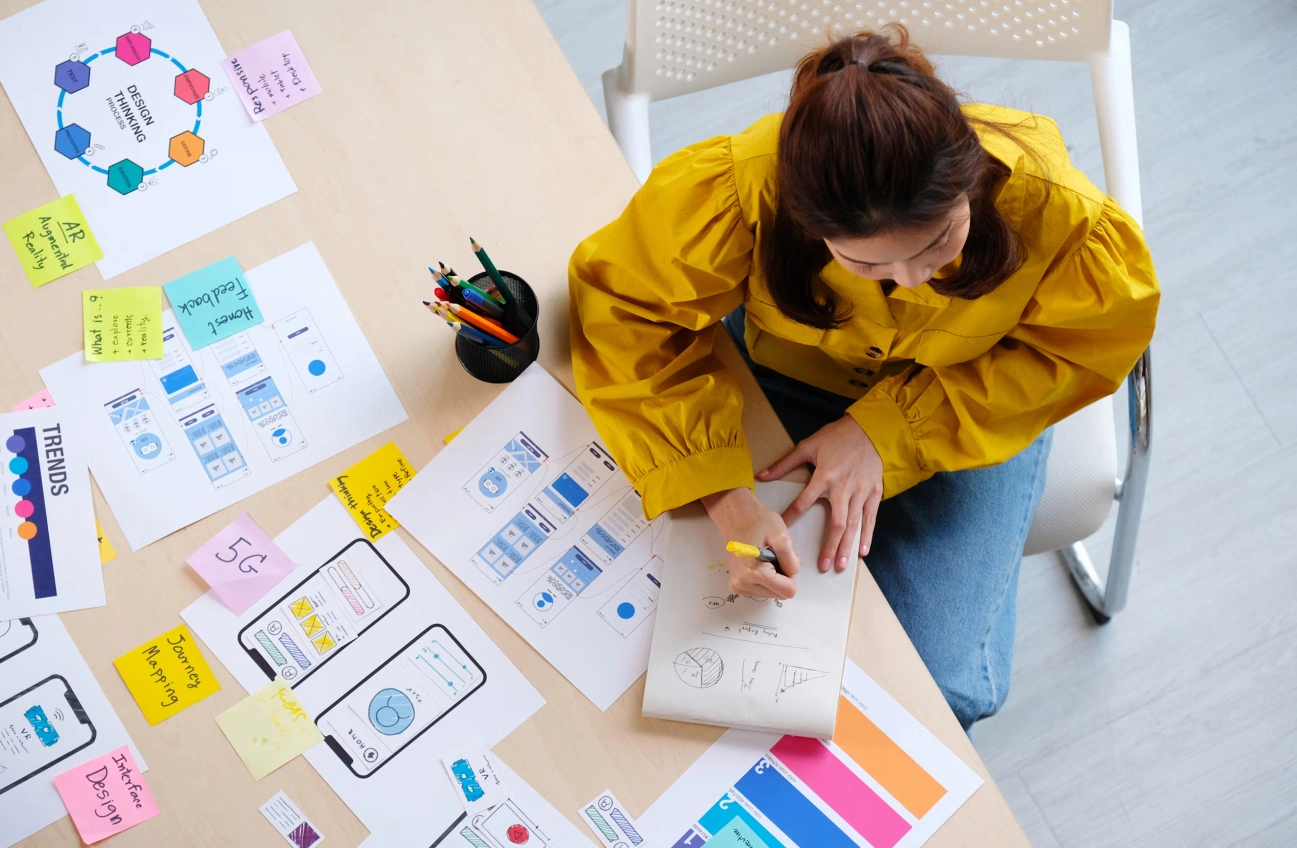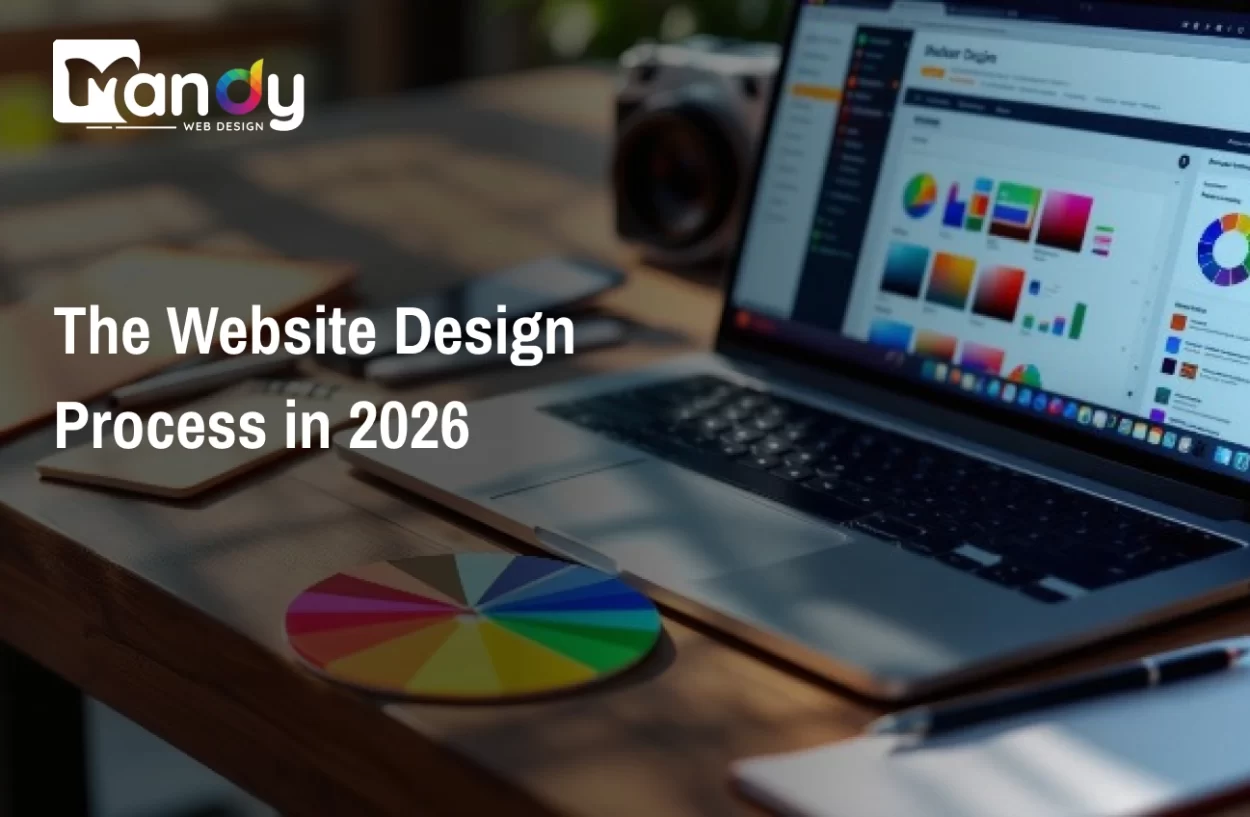Website design has evolved a lot, and 2026 brings exciting changes that every business should know about. Today, it’s not just about creating a website that looks nice — it’s about building one that’s fast, user-friendly, and smart enough to meet customer needs.
Did you know? 73% of users access websites via mobile devices, so designing for all screen sizes is critical in 2026.
With AI design tools, no-code builders, and new UX trends, the website design process in 2026 is simpler, faster, and more effective than ever. From planning and layouts to testing and launching, every step now focuses on improving user experience, speed, and personalization.
In this blog, we’ll walk you through what’s new in website design, which strategies still work best, and how you can create a future-ready website for your business. Whether you’re redesigning your current site or starting from scratch, this guide will help you understand how modern web design truly works in 2026.
Let’s explore this step by step!
Why Website Design Still Matters in 2026
Even as tools evolve and automation rises, the basic reason your website matters hasn’t changed—it’s still often the first place a customer meets your brand online. A well-designed website builds trust, shows professionalism, and guides visitors toward what you want them to do: contact you, buy from you, sign up, or learn more.
In 2026, user expectations have shifted. People expect websites to load almost instantly, adapt to any device (from smartphones to large monitors), and be intuitive. Slow load times, confusing menus, or bad mobile experiences are no longer just minor annoyances—they cost you business. For example, if your site still takes several seconds to load on mobile, many users will leave before even seeing your content.
Additionally, good design impacts your visibility online. Search engines like Google LLC reward fast, mobile-friendly, and SEO-friendly website structure. A modern design that aligns with SEO best-practices helps you rank better. In short: design in 2026 is about function + form, not just appearance.
The Complete Website Design Process in 2026
Here’s a step-by-step breakdown of how to build a website in 2026, with what’s changed and what still works.
Step 1: Research & Planning

What you do: A good design starts with understanding your audience, goals, and brand identity — and selecting the right web design layouts to match your message. Define your business goals, identify your target audience, map out competitors, and set project scope (pages, functionality, budget, timeline).
What’s new: You can now use AI tools for deeper insights—e.g., user behaviour prediction, competitor layout scanning, and content gap analysis. These tools help you plan more accurately and faster.
What still works: The basic questions remain: Who is your audience? What do they want? What actions should they take once on your site? Solid planning reduces surprises later.

What you do: Create rough drawings (wireframes) of how pages will lay out, plan the user-journeys (how a user moves through the site) and decide on UX factors such as navigation, accessibility, performance.
What’s new: No-code/prototype tools have become more powerful—with AI suggesting layouts, testing flows, and even simulating user interactions. You’ll see faster iterations.
What still works: Focusing on clear navigation, hierarchy of information, mobile-first design and making sure the site is accessible to all users remains essential. A confusing menu or unclear path still kills conversions.
Step 3: UI Design & Prototyping

What you do: Turn wireframes into high-fidelity mockups: colours, typography, imagery, interactive elements. Create clickable prototypes to test look-and-feel.
What’s new: Top web design companies in 2026 adopt design trends like immersive 3D elements, motion UI, dark mode support, variable fonts, and micro-interactions. For example: 3D visuals or subtle motion to make the site feel alive.
What still works: The timeless principles: brand consistency (logo, colour palette), readability (good typography, contrast), meaningful imagery. These form the foundation no matter the trend.
Step 4: Development & Integration

What you do: Build the website—front-end (HTML/CSS/JS) and back-end if needed. Integrate CMS, forms, e-commerce, APIs. Ensure responsiveness across devices.
What’s new: The rise of no-code/low-code platforms means smaller businesses can build faster. Also, AI-driven code generation or layout generation is becoming a reality. Some portions of site building are being automated.
What still works: Clean code, mobile-first responsive design, performance optimisation (compressing images, minifying code), browser compatibility—all remain crucial. If a site doesn’t work well on mobile, it fails.
Step 5: Testing & Optimisation

What you do: Carry out usability testing, performance testing (speed, responsiveness), accessibility testing, cross-browser/device testing. Fix bugs and optimise for performance and SEO.
What’s new: Performance metrics such as Core Web Vitals (like interaction to next paint) are more important than ever.AI tools can scan for UX issues or suggest speed improvements.
What still works: User feedback still matters. Watching real users navigate your site will reveal issues no tool can always predict. Manual checks ensure quality.
Step 6: Launch & Maintenance

What you do: Deploy your website live, ensure analytics are set up (e.g., tracking conversions, user flows), monitor performance. Then plan ongoing updates (content, design tweaks, new features).
What’s new: With rapidly changing trends and user expectations, websites now need more frequent updates. Also, dynamic content and personalisation are now built in from day one.
What still works: A website is not a “set-and-forget” project. Regular maintenance, monitoring, backups, and updates to content are essential to keep the site performing well and remaining secure.
What’s New in Website Design in 2026
In 2026, clean UI and minimal layouts will dominate, focusing on strategies that improve website UX and make navigation effortless for users .These UI/UX trends are shaping how designers approach modern web experiences, emphasizing simplicity, accessibility, and user-centered functionality.
AI-Driven Personalisation: Websites don’t just display the same content to every visitor. They adapt layout, content, visuals and offers based on user behaviour, location, device, and preferences.
Immersive 3D & Interactive Elements: With better browser support and tools, 3D models, interactive visuals and rich motion are no longer niche—they’re becoming mainstream.
Dark Mode & Adaptive Themes: Dark mode is now a standard expectation, and websites must support multiple display modes for improved usability.
Micro-Animations & Motion UI: Small, purposeful animations (button hover effects, scroll transitions, input field reactions) are being used to enhance UX—not distract.
Voice User Interfaces (VUIs): With more voice search and smart devices, websites are being designed to support voice commands and conversational flows.
Accessibility-First & Inclusive Design: Design for all users—mobile, desktop, those with disabilities—is non-negotiable. Accessibility is now built into the design process, not bolted on later.
Performance & Mobile-First Priority: Speed, responsiveness, seamless mobile experience are stronger ranking and conversion factors than ever.
What Still Works (Proven Design Practices That Never Fail)
While every new website design trend comes and goes, certain design foundations remain solid and timeless. Here’s what you should always keep in mind.
Clear Navigation & Simple Layouts: No matter how fancy your design, if visitors can’t find what they want quickly, they’ll leave.
Mobile Responsive & Fast Loading: With the majority of visitors on mobile devices, mobile-first design and fast load times are essential.
SEO-Friendly Structure: Clean URLs, headings (H1, H2…), alt text, fast pages help you rank better and get found.
Readable Typography & Quality Visuals: Fonts must be legible across devices; images should be sharp but optimised for performance.
Consistent Branding & Trust-Building: Strong visuals, consistent colours, brand voice, and trust signals (like testimonials, secure badges) build credibility.
Usability & Accessibility: Designing with all users in mind (including those with disabilities) makes your site better for everyone—and it often improves SEO.
Content Value & User Focus: Good design serves the user. The best websites are built around helping users do what they came to your site for.
Cost & Timeline of Website Design in 2026
Many business owners ask: “How long will it take to build a website?” and “How much will it cost to design a website?” While each project is different, here are generalities for 2026.
Timeline factors:
- Small website (5-10 pages, simple functionality): ~4-6 weeks.
- Medium website (20-30 pages, blog, some integration, custom design): ~8-12 weeks.
- Large website (many pages, e-commerce, complex integrations, custom animations/3D): 3-6 months+.
Cost factors:
- Complexity of design (animations, 3D, personalisation) raises cost.
- Custom development vs template/no-code solution.
- Content creation (text, images, video) adds cost.
- Ongoing maintenance and updates should be budgeted for.
It’s important to balance your budget with your goals. A cheap site may look ‘ok’ today but could struggle in performance or scalability tomorrow. Investing in a well-built, future-proof website will pay off.
Expert Tips to Build a Future-Ready Website
Here are some actionable tips you can apply now to ensure your website is built for 2026 and beyond:
- Design for flexibility and scalability. Use modular design systems so you can add or adjust features without rebuilding.
- Focus on accessibility. Ensure your site meets WCAG guidelines, offers keyboard navigation, alt text for images, and is mobile-friendly.
- Test regularly and iterate. Use analytics to monitor user behaviour. Update your site based on real user feedback—not just design instinct.
- Blend SEO and UX. Good design should help users and search engines. Fast load time, mobile responsiveness, and clear structure help both.
- Don’t follow every trend blindly. Only add features/trends that make sense for your audience and goals. A fancy 3D animation is worthless if it slows loading.
- Stay ahead of mobile and voice. Optimise for mobile devices as a primary experience and consider voice navigation if your audience uses it.
- Prioritise performance. Even advanced features must load quickly. Use image compression, lazy loading, efficient code.
- Use analytics and personalisation. Track what users do, segment your audience, and tailor the experience to them. That’s what modern websites are doing.
The Future of Website Design
What might the next few years bring beyond 2026? Here are some predictions.
- Fully AI-Driven Design & Personalisation. The website will adapt dynamically to each visitor’s behaviour, context, device, and even mood. Layouts, visuals and content will change in real time.
- Immersive Web Experiences (AR/VR). Especially for product brands and services, websites may offer augmented reality previews, virtual showrooms and immersive navigation.
- Voice & Conversational User Interfaces Everywhere. More users may navigate sites using voice commands, or sites may guide users conversationally (chat-first design).
- Design Systems as Living Ecosystems. Rather than one-off websites, brands will maintain design ecosystems that feed multiple touchpoints (web, mobile, IoT).
- Data-Driven UX & Adaptive Journeys. Websites will increasingly use real-time data and predictive analytics to change user journeys on the fly.
- Sustainability & Performance Ethics. Web design will also consider environmental impact: lighter pages, efficient code, green hosting—as users and brands become more conscious.
Why Choose Mandy Web Design for Your 2026 Website Project
If you’re planning to create a powerful online presence in 2026, Mandy Web Design is the best web design agency you can rely on. We blend creativity, innovation, and the latest technology to design websites that truly perform — not just look good.
Our team of top web designers specializes in custom web design that aligns with your brand’s goals and audience needs. Whether you’re looking for engaging UI/UX design, high-performing WordPress web design, or robust Laravel Web Design, we deliver solutions that are both visually stunning and strategically built.
We also offer full website redesign services for businesses looking to modernize outdated sites and make them faster, smarter, and more user-friendly. Every project we handle focuses on responsive web design, ensuring your website looks and functions perfectly on all devices — from desktop to mobile.
We don’t just build websites — we build digital experiences that attract, engage, and convert. Let’s create a future-ready design that helps your business stand out in 2026 and beyond.
Need a Modern Website in 2026?
Partner with our professional web design agency that delivers visually stunning, high-performing, and business-focused websites!
FAQs About Website Design Process
The website design process involves researching, planning, designing, developing, testing, and launching a website. It ensures your site looks appealing, functions properly, and delivers a great user experience while achieving your business goals and improving online visibility effectively.
The timeline for a website design project depends on complexity and features. A basic website can take 4–6 weeks, while larger, customized, or eCommerce sites may take up to 12 weeks, including testing and revisions for best results.
The main stages of the website design process include planning, wireframing, design, development, testing, and launch. Each step focuses on user experience, performance, and functionality to create a website that attracts visitors and meets business objectives efficiently.
Website design is crucial in 2026 because it impacts user experience, conversions, and SEO. A well-designed site builds trust, keeps visitors engaged, and helps businesses establish credibility while ranking higher on search engines for better online performance and visibility.
Website design costs depend on features, complexity, and tools used. Simple websites cost around $1,000–$2,000, while advanced or custom web design projects with animations, integrations, or eCommerce functionality may cost $5,000–$10,000 or even more, depending on requirements.
In 2026, web design trends include AI-driven personalization, voice-activated navigation, immersive 3D visuals, adaptive layouts, and motion UI. No-code tools and smart automation make creating responsive, accessible, and high-performing websites easier, faster, and more user-focused than before.
Responsive web design ensures your website automatically adjusts to any screen size. It provides consistent usability and performance across mobile, tablet, and desktop devices, improving user experience, engagement, and SEO rankings while reducing bounce rates significantly for businesses worldwide.
Custom web design gives your business a unique identity by aligning visuals, features, and structure with your brand. It’s flexible, scalable, SEO-friendly, and built for your specific audience, helping you stand out and improve user engagement effectively long-term.

About the Writer
Abhishek Thakur
Sr. Content Writer at Mandy Web Design
Abhishek Thakur is the Senior Content Writer at Mandy Web Design, where he crafts engaging content for the company’s website, blog, and marketing campaigns. With 5+ years of experience in digital marketing and SEO content creation, he specializes in turning complex topics into easy-to-understand, actionable strategies that help businesses grow online. He is passionate about creating high-quality, value-driven content that connects with audiences and builds brand authority. When he’s not writing, he enjoys exploring new ideas, learning the latest marketing trends, and improving his creative skills.



